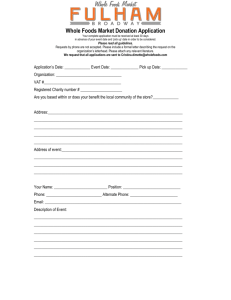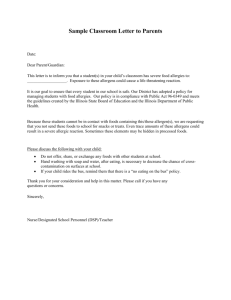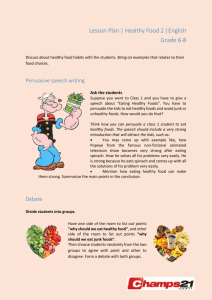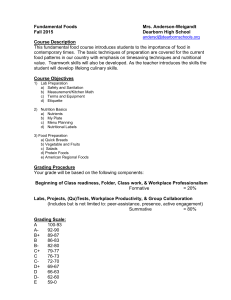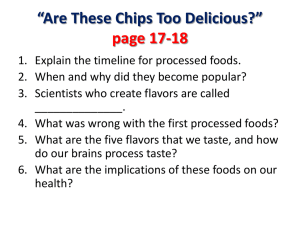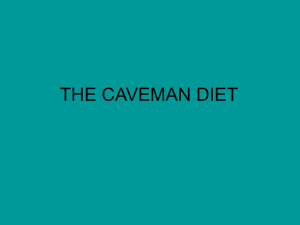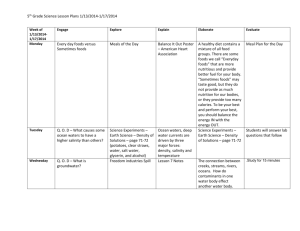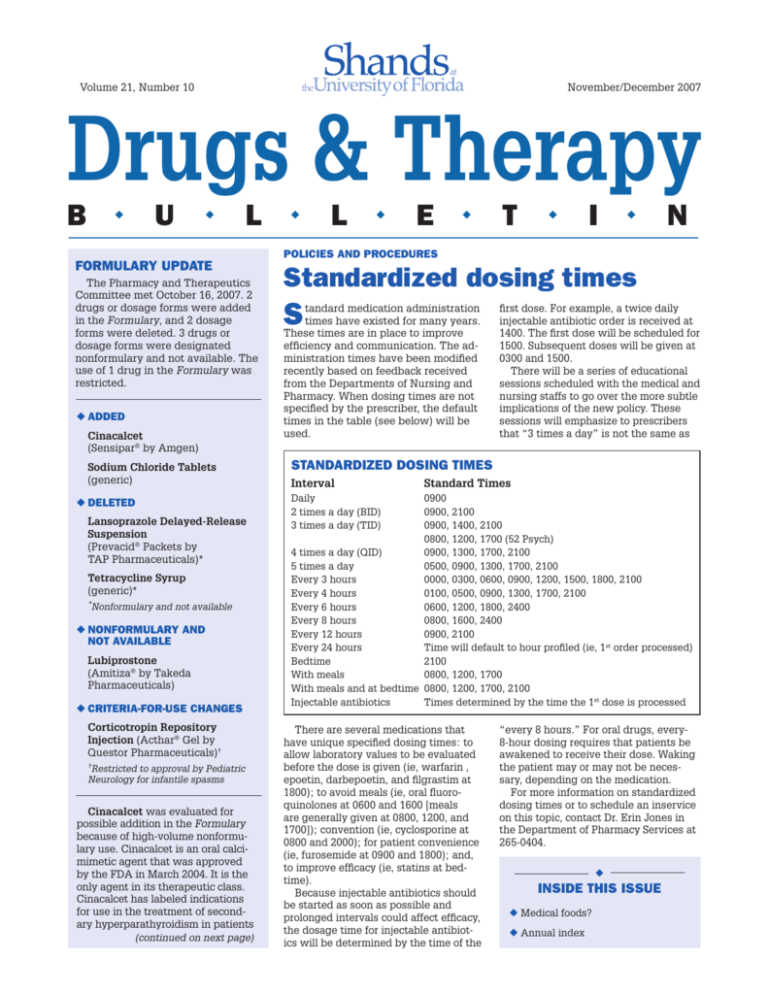
Volume 21, Number 10
November/December 2007 Drugs & Therapy
B
U
�
�
L
FORMULARY UPDATE
The Pharmacy and Therapeutics
Committee met October 16, 2007. 2
drugs or dosage forms were added
in the Formulary, and 2 dosage
forms were deleted. 3 drugs or
dosage forms were designated
nonformulary and not available. The
use of 1 drug in the Formulary was
restricted.
◆ADDED
Cinacalcet
(Sensipar® by Amgen)
Sodium Chloride Tablets
(generic)
◆ DELETED
Lansoprazole Delayed-Release
Suspension
(Prevacid® Packets by
TAP Pharmaceuticals)*
Tetracycline Syrup
(generic)*
*Nonformulary and not available
◆NONFORMULARY AND
NOT AVAILABLE
Lubiprostone
(Amitiza® by Takeda
Pharmaceuticals)
◆CRITERIA-FOR-USE CHANGES
Corticotropin Repository
Injection (Acthar® Gel by
Questor Pharmaceuticals)†
†
Restricted to approval by Pediatric
Neurology for infantile spasms
Cinacalcet was evaluated for
possible addition in the Formulary
because of high-volume nonformulary use. Cinacalcet is an oral calcimimetic agent that was approved
by the FDA in March 2004. It is the
only agent in its therapeutic class.
Cinacalcet has labeled indications
for use in the treatment of secondary hyperparathyroidism in patients
(continued on next page)
�
L
�
E
�
T
�
I
�
N
POLICIES AND PROCEDURES
Standardized dosing times
S
tandard medication administration
times have existed for many years.
These times are in place to improve
efficiency and communication. The administration times have been modified
recently based on feedback received
from the Departments of Nursing and
Pharmacy. When dosing times are not
specified by the prescriber, the default
times in the table (see below) will be
used.
first dose. For example, a twice daily
injectable antibiotic order is received at
1400. The first dose will be scheduled for
1500. Subsequent doses will be given at
0300 and 1500.
There will be a series of educational
sessions scheduled with the medical and
nursing staffs to go over the more subtle
implications of the new policy. These
sessions will emphasize to prescribers
that “3 times a day” is not the same as
Standardized Dosing Times
Interval
Standard Times
Daily
0900
2 times a day (BID)
0900, 2100
3 times a day (TID)
0900, 1400, 2100
0800, 1200, 1700 (52 Psych)
4 times a day (QID)
0900, 1300, 1700, 2100
5 times a day
0500, 0900, 1300, 1700, 2100
Every 3 hours
0000, 0300, 0600, 0900, 1200, 1500, 1800, 2100
Every 4 hours
0100, 0500, 0900, 1300, 1700, 2100
Every 6 hours
0600, 1200, 1800, 2400
Every 8 hours
0800, 1600, 2400
Every 12 hours
0900, 2100
Every 24 hours
Time will default to hour profiled (ie, 1st order processed)
Bedtime
2100
With meals
0800, 1200, 1700
With meals and at bedtime 0800, 1200, 1700, 2100
Injectable antibiotics
Times determined by the time the 1st dose is processed
There are several medications that
have unique specified dosing times: to
allow laboratory values to be evaluated
before the dose is given (ie, warfarin ,
epoetin, darbepoetin, and filgrastim at
1800); to avoid meals (ie, oral fluoroquinolones at 0600 and 1600 [meals
are generally given at 0800, 1200, and
1700]); convention (ie, cyclosporine at
0800 and 2000); for patient convenience
(ie, furosemide at 0900 and 1800); and,
to improve efficacy (ie, statins at bedtime).
Because injectable antibiotics should
be started as soon as possible and
prolonged intervals could affect efficacy,
the dosage time for injectable antibiotics will be determined by the time of the
“every 8 hours.” For oral drugs, every8-hour dosing requires that patients be
awakened to receive their dose. Waking
the patient may or may not be necessary, depending on the medication.
For more information on standardized
dosing times or to schedule an inservice
on this topic, contact Dr. Erin Jones in
the Department of Pharmacy Services at
265-0404.
◆
INSIDE THIS ISSUE
◆ Medical foods?
◆ Annual index
2
Formulary update, from page 1
with chronic kidney disease on dialysis
and for the treatment of hypercalcemia
in patients with parathyroid carcinoma.
Chronic kidney disease is associated
with hyperphosphatemia, hypocalcemia, and increased stimulation of the
parathyroid gland. These alterations
lead to secondary hyperparathyroidism, a progressive condition that
eventually results in bone disease
and calcification of vascular and soft
tissues.
Cinacalcet acts on the calciumsensing receptor on the surface of the
chief cell in the parathyroid gland. The
calcium-sensing receptor is the principal regulator of parathyroid hormone
(PTH) secretion. By mimicking calcium,
cinacalcet increases the sensitivity of
the calcium-sensing receptor to extracellular calcium and lowers PTH levels.
Decreased serum calcium is associated
with reduction in PTH. After 1 week of
therapy, reduction in serum calcium is
seen and maintained.
Managing patients, according to the
National Kidney Foundation’s Kidney
Disease Outcomes Quality Initiative (K/
DOQI) guidelines on bone metabolism
and disease in chronic kidney disease,
can be challenging. Traditional therapies for stage 5 chronic kidney disease
include phosphate-binders and vitamin
D sterols and can be associated with
hypercalcemia.
Evidence from randomized, placebocontrolled trials in dialysis patients
shows that cinacalcet is effective in
reducing intact PTH while also reducing serum calcium, phosphorus, and
calcium-phosphorus product. At the
start of these studies, patients had
elevated PTH in spite of treatment
with phosphate binders and/or vitamin
D sterols. At this time, a large prospective, randomized, placebo-controlled
trial is being conducted to determine if
cinacalcet reduces the risk of mortality
or cardiovascular events in hemodialysis patients.
The most common adverse events
associated with cinacalcet use are
nausea and vomiting. Cinacalcet may
be associated with increased risk of
seizures, hypocalcemia, and adynamic
bone disease. Drug interactions involving the cytochrome P450 enzyme
system are possible with concomitant
cinacalcet therapy. Increased monitoring of serum calcium and PTH may
be necessary to manage the risks of
severe adverse events.
Compared with other oral medications, cinacalcet is quite expensive.
Based on typical dosages, it will cost
approximately $1000 per month.
Sodium chloride tablets were
deleted from the Formulary during a
time of shortage. The shortage has
been resolved, and there is now a need
to re-add this dosage form back in the
Formulary.
The new enteral feeding system used
by Dietary Services does not allow the
addition of specific electrolytes. Extra
sodium chloride must be administered
separately. This is usually done using
sodium chloride 4 mEq/mL injection in
an oral syringe. However, adult and
older pediatric patients who can take
oral solids can be supplemented with
1-gram sodium chloride tablets (ie, delivering 17.2 mEq of sodium per tablet).
Prevacid® for Delayed-Release Oral
Suspension Packets will no longer be
marketed by TAP Pharmaceuticals. This
product is not used much; other dosage
forms are more popular. The packets
were deleted from the Formulary and
designated nonformulary and not available.
Lansoprazole suspension compounded using sodium bicarbonate is a better
alternative for administering lansoprazole down a feeding tube. Prevacid®
Oral Suspension Packets produced a
thick suspension because it contained
xanthan gum to increase viscosity. This
thick suspension often clogged feeding
tubes, especially small-bore feeding
tubes.
Prevacid® SoluTabs® have a pleasant taste and can be used to administer
lansoprazole orally in small children who
cannot swallow capsules. The SoluTabs®
can also be dissolved in a small amount
of water and administered down a feeding tube. The granules in the SoluTabs®
do not clump or stick to the feeding tube.
Tetracycline syrup has been discontinued by its manufacturer. There is no
alternative source. After consulting with
the Infectious Diseases Subcommittee,
there appears to be no need to recommend an alternative agent. Tetracycline
syrup was designated nonformulary and
not available.
Lubiprostone was evaluated for possible addition in the Formulary based on
requests for use and potential for inappropriate off-label use.
Lubiprostone is a member of a new
class of bicyclic fatty acids prostaglandin E1 derivatives known as prostones.
It increases intestinal fluid secretion via
a novel mechanism of action by specifically activating type 2 chloride channels.
The secretions subsequently soften
the stool, increase intestinal motility,
promote spontaneous bowel movements, and relieve signs and symptoms
of constipation.
Lubiprostone is administered
orally and has low systemic availability.
Plasma concentrations are below the
level of detection; there are no known
drug interactions. A clinically meaningful effect usually occurs within 1 week
of administration, and tolerance to use
has not been observed during clinical
trials. Additionally, a sustained response
has been shown 3 weeks after stopping
therapy.
Lubiprostone, which was approved by
the FDA in January 2006, currently only
has an FDA-labeled indication for the
treatment of chronic idiopathic constipation. The labeled dose is 1 capsule
(24 mcg) twice daily with meals. The
drug has not been specifically studied in patients with hepatic or renal
impairment, but the need for dosage adjustments is unlikely as it has
minimal systemic availability. Safety
and efficacy have not been established
in children or adolescents. A lower
strength of lubiprostone (ie, 8 mcg) to
treat irritable bowel syndrome with
constipation is currently under review
by the FDA.
There are no head-to-head studies
comparing lubiprostone to other agents
used to treat chronic constipation (ie,
bulk-forming fiber products or stool
softeners). The approval of lubiprostone was primarily based on 2 randomized, double-blind, placebo-controlled,
phase 3 trials that showed moderate improvements in weekly bowel
movements (ie, an absolute increase
of approximately 2 bowel movements
per week [approximately 3 vs 5]). Also,
only approximately 60% of patients
had a spontaneous bowel movement in
the first 24 hours of treatment.
The most commonly reported adverse effect during clinical trials was
nausea. The incidence of nausea is
dose-related; 8% of patients discontinued treatment during trials due to nausea. Other common side effects during
trials included diarrhea, headache, and
abdominal pain or distension.
Chronic constipation is primarily
treated on an outpatient basis. There
are various low-cost formulary options available for acute treatment of
constipation (eg, senna), as well as
fiber products and stool softeners for
possible prevention. Patients admitted who are already taking lubiprostone may take their own supply or be
treated with other formulary agents
for constipation during hospitalization. Additionally, discontinuation
of lubiprostone does not result in a
rebound effect and, in fact, shows a
sustained response 3 weeks after stopping the drug. Therefore, lubiprostone
was designated nonformulary and not
available.
Acthar® Gel remains listed in the
Formulary; however, it is now restricted to prior approval by Pediatric
Neurology for use in the treatment of
infantile spasms. Product will not be
stocked for use in the hospital and
will be obtained only for use in
patients who have been approved
for use in the product’s restricteddistribution program.
The changes in the formulary status
of Acthar® Gel are the result of Questor
Pharmaceuticals’ recent announcement that it increased the cost of a
5-mL multi-dose vial (80 units/mL)
from its previous price of about $1,500
(continued on next page)
Formulary update, from page 2
per vial to $23,000 per vial! This is
more than a 15-fold increase. The
manufacturer states this price is in line
with other drugs that are used to treat
rare disorders.
Shands at UF has been a relatively
heavy user of Acthar® Gel. Without the
current restrictions, there could have
been an increase in pharmaceutical
expenditures of $1.4 million.
A review of the last year’s Acthar®
Gel use showed that most was being
used for the treatment of acute gout.
There are multiple alternative agents
that can be used to treat an acute
exacerbation of gout. Nonsteroidal
anti-inflammatory agents (NSAIDs)
and colchicine are commonly used.
However, patients who cannot tolerate
an NSAID or colchicine can be treated
with corticosteroids. Intra-articular
steroids are an option when 1 or fewer
joints are involved. There are several
other oral and parenteral alternatives
to Acthar® Gel.
Oral prednisone (20-60 mg per day
tapered over 10 days) is an option for
patients who can take oral medications.
Intramuscular or intravenous methylprednisolone (100 mg per day with
taper) is another inexpensive alternative. There are also data supporting the
use of a 60-mg dose of intramuscular triamcinolone acetonide for the treatment
of gout, but this is nearly 17-times more
expensive than methylprednisolone.
Cosyntropin (Cortrosyn®), a synthetic
form of adrenocorticotropic hormone
(ACTH) that contains the biologically active amino acid portion of ACTH, can be
used as an alternative to Acthar® Gel for
the treatment of gout. Cosyntropin has
less antigenicity than natural ACTH.
Studies showing benefit from ACTH
in gout did not use synthetic ACTH.
However, cosyntropin does stimulate
the adrenal cortex maximally and to the
same extent as an equivalent dose of
natural ACTH. Additionally, the common
extra-adrenal effects including increased
melanotropic activity, increased growth
hormone secretion, and adipokinetic
effects are also similar.
According to Cortrosyn® labeling, 25
units of corticotropin is pharmacologically equivalent to 0.25 mg cosyntropin based on the level of stimulation
on the adrenal cortex. Based on this
conversion, 0.4 to 0.8 mg of cosyntropin would be an equivalent dose for
treating gout (ie, equal to a 40 to 80
unit dose of Acthar® Gel). This treatment is as much as 300 times more
expensive than methylprednisolone.
Acthar® Gel is about 15 times more
expensive than cosyntropin. A table
with drug, dosage, and cost comparisons of drugs used for the treatment
of acute gout can be found on the
intranet at http://intranet.shands.org/
pharm/Acute_Gout_Rx.pdf.
Acthar® Gel has also been used to
treat multiple sclerosis exacerbations.
There are other alternatives (eg,
methylprednisolone) that are
preferable in this condition.
NEWS
Medical foods: Drug, dietary supplement, food, or other?
W
hat is a medical food? Is it a
drug? Is it a dietary supplement?
Is it a food? Or maybe it’s something
else entirely? If you answered “something else entirely,” you are correct.
The term “medical food” is officially
defined by the FDA in a section of
the Orphan Drug Act Amendments of
1988. The term “medical food” does
not simply apply to all foods fed to sick
patients. A medical food is “a food
which is formulated to be consumed
or administered enterally under the
supervision of a physician and which is
intended for the specific dietary management of a disease or condition for
which distinctive nutritional requirements, based on recognized scientific
principles, are established by medical
evaluation.”A couple key points are:
physician supervision, taken orally, and
taken for a specific nutritional need for
a certain condition. A medical food is
NOT required to be prescription only;
over-the-counter products can be used
under medical supervision.
So how are medical foods regulated?
Since they fall into a unique class they
are regulated differently than both
drugs and dietary supplements.
Medical foods do NOT have to
undergo pre-marketing review or be
approved by the FDA; individual medical food products do not have to be
registered with the FDA. Additionally,
medical foods are exempted from the
labeling requirements for health claims
and nutrient content claims under the
Nutrition Labeling and Education Act
of 1990. As a result, medical foods are
not limited to the “structure/function”
claims for dietary supplements. Manufacturers can make disease-specific
statements for these products.
Medical foods are foods, however,
and are at least required to have a
certain amount of labeling. This must
include: a statement of identity; an accurate statement of the net quantity of
contents; name and place of business
of the manufacturer, packer, or distributor; and a complete list of ingredients.
Also the Food Allergen Labeling and
Consumer Protection Act (FALCPA) require that medical foods include on the
label the food source name of any major
allergens (ie, peanuts, eggs, shellfish).
Furthermore, medical foods must comply with all applicable requirements for
the manufacture of foods in general,
such as the Current Good Manufacturing Practices regulations.
So what are the implications of the
lax regulation of medical foods? Due
to lack of regulatory control, the FDA
historically has paid little attention to
medical foods. This created an environment wherein manufacturers — taking
advantage of an opportunity not to
have to get FDA approval — started
to market a variety of food products as
medical foods, regardless if they qualify
as such.
Based on possible safety concerns,
the FDA has recently developed a Compliance Program specifically for
medical foods. This program enables
FDA inspectors to do the following:
(1) obtain information regarding the
manufacturing/control processes and
quality assurance programs employed
by domestic manufacturers of medical
foods through establishment inspections, (2) collect domestic and import surveillance samples of medical
foods for nutrient and microbiological
analyses, and (3) take action when significant violations of the Federal Food,
Drug and Cosmetic Act (or related
regulations) are found.
What medical foods are available?
The prototypical example of a medical
food is the phenylalanine-free nutritional supplement (PhenylAid®) for patients
with phenylketonuria (PKU). Other
examples of products that claim to be
medical foods include: L-methylfolate
(Deplin®) for depression; flavocoxid
(Limbrel®) for osteoarthritis; lactic
acid bacteria (VSL#3®) for ulcerative
colitis, IBS, or ileal pouch; Complex
MSUD® Drink Mix for branched-chain
alpha-keto acid dehydrogenase
deficiency (Maple Syrup Urine Disease); UltraClear® for chronic fatigue
syndrome; Estrium® for symptoms
related to the “female hormone cycle”;
UltraGycemX® for conditions associated with type 2 diabetes; and TramaCal® Liquid for metabolically stressed
patients (eg, burn patients). Many of
these products have a Web page if you
are interested in additional information; however, some of the claims made
for these products are not backed by
the standards of evidence that we
would expect for drugs.
By Russell McKelvey, PharmD
References
Guidance for Industry: Frequently Asked Questions About
Medical Foods. U.S. Department of Health and Human Services Food and Drug Administration Center for Food Safety
and Applied Nutrition. May 2007. Accessible at: http://www.
cfsan.fda.gov/~dms/medfguid.html.
3
Drugs & Therapy
B
�
U
�
L
�
L
�
E
�
T
�
I
�
N
Volume 21, No. 10
Nov./Dec. 2007
This publication is produced by the
Drug Information and Pharmacy Resource Center under the direction of
the Department of Pharmacy Services
and the Pharmacy and Therapeutics
Committee.
SHANDS
Shands at the University of Florida
DRUG INFORMATION SERVICE
PO Box 100316
Gainesville, FL 32610-0316
NON-PROFIT ORG.
U.S. POSTAGE
PAID
GAINESVILLE, FL
PERMIT NO. 94
EDITOR,
DRUGS & THERAPY BULLETIN
Randy C. Hatton, PharmD
DIRECTOR,
PHARMACY SERVICES
Alan Knudsen, MS, RPh
CHAIRMAN,
PHARMACY & THERAPEUTICS
COMMITTEE
Ricardo Gonzalez-Rothi, MD
EDITING, DESIGN, & PRODUCTION
Shands HealthCare’s Publication Svcs.
© Copyright 2007. All rights reserved.
No portion of the Drugs & Therapy
Bulletin may be reproduced without
the written consent of its editor.
FOR MORE INFORMATION,
VISIT US ONLINE
http://shands.org/professionals/
druginfo/bulletin.asp
2007 Annual index
4
TOPIC..........................................ISSUE/PAGE(S)
Acthar® Gel..........................................September/4
....................................... November–December/1–3
Albumin.................................................. February/3
.................................................................... May/1–2
Aminoglutethimide.................................. April/1–2
Amprenavir........................................ February/1–2
Anidulafungin...................................... January/1–2
Antihemophilic Factor.....................September/1–3
Antihemophilic Factor, Porcine......September/1–3
Antimicrobial Management......................... April/3
Aripiprazole................................................June/1–2
Benazepril-Lisinopril
Interchange.................................... February/1–2
Benzylpenicilloyl-Polylysine
Skin Test.......................................... February/1–2
Buprenorphine.................................September/1–2
Buprenorphine-Naloxone................September/1–2
Caffeine Tablets...............................September/1–2
Calcium Chloride............................. July–August/4
Calcium Gluconate.......................... July–August/4
Cefixime............................................September/1–2
Ceftriaxone.................................................. May/1,3
Charity Care Formulary................................ May/1
Cinacalcet..................... November–December/1–2
Cockroft-Gault Equation............................ March/3
Conivaptan................................... July–August/1–2
Cyanide Antidote Kit........................September/1,3
Cyclosporine, Generic................................ March/1
Cyclosporine, Gengraf®.............................June/1–3
Cyclosporine, Neoral®...............................June/1–3
Darbepoetin................................................. May/1,3
........................................................................June/1
Darbepoetin-Epoetin Interchange.......... January/1
...........................................................September/1,3
Decitabine............................................... March/1–2
Desonide Ointment.............................. January/1–2
Disposal of Drugs.......................................... April/3
Doctoring Orders...........................................June/3
Duloxetine............................................... March/1–2
Enteral Feeding Tubes,
Drug Administration........................... March/3–4
Epoetin........................................................ May/1,3
........................................................................June/1
TOPIC..........................................ISSUE/PAGE(S)
Epoetin-Darbepoetin Interchange.......... January/1
...........................................................September/1,3
Erythropoiesis-Stimulating Agent
Protocol..............................................September/1
Esomeprazole............................... July–August/1–2
Fluticasone-Mometasone Nasal
Spray Interchange............................ January/1–2
Fluvastatin................................................ April/1–2
Gammagard® S/D............................... February/1–2
Generic Drugs............................................. May/1,3
Gonadorelin.......................................September/1,3
Halothane............................................. January/1–2
Heparin Levels........................................... April/1,4
Histamine Skin Test.......................... February/1–2
Hydroxocobalamin...........................September/1–2
Hydroxyzine Syrup...................... July–August/1–2
Hyoscyamine..............................................June/1–2
Imipenem..........................................September/1,3
Immune Globulin, Intravenous......... February/1–3
Infliximab...................................... July–August/1,3
Insulin Aspart-Insulin Aspart
Protamine......................................September/1–2
Insulin Detemir....................................... March/1–2
Insulin Glargine...............................September/1–2
Insulin Lispro-Insulin Lispro
Protamine......................................September/1–2
Iron Sucrose Injection................................June/1–2
Itraconazole.......................................September/1,3
Ketorolac.................................................... April/1–2
Lansoprazole............................................... May/1,3
Lansoprazole Suspension
Packets....................... November–December/1–2
Levetiracetam.................................... February/1–2
Lidocaine Patches...................................... May/1–2
Lisinopril-Benazepril Interchange.... February/1–2
Lovastatin.................................................. April/1–2
Lubiprostone................. November–December/1–2
MDRD Equation.......................................... March/3
Medical Foods.................. November–December/3
Meningococcal Vaccine.......................... March/1–2.
....................................................................June/3–4
Meropenem.......................................September/1,3
Micafungin........................................... January/1–2
TOPIC......................................... ISSUE/PAGE(S)
Mometasone-Fluticasone Nasal Spray
Interchange....................................... January/1–2
Morphine Extended-Release............ February/1–2
MS-Contin®-Oramorph®
Interchange..................................... February/1–2
Mycophenolate......................................... April/1–2
New Drugs 2006................................. February/1,4
Off-Label Promotion............................... March/1–2
Olanzapine.................................................June/1–2
Oramorph®-MS-Contin®
Interchange..................................... February/1–2
Pegfilgrastim................................................. April/1
Pergolide.................................................... May/1–2
Pioglitazone.................................. July–August/1–2
Pneumococcal Vaccine.................... July–August/1
Posaconazole........................................ January/1–2
Potassium Chloride....................................June/1,3
Pravastatin................................................ April/1–2
Promethazine....................................... January/3–4
Propoxyphene...................................September/1,3
Quinine................................................ . January/1,3
Ranolazine................................................. April/1–2
Rosuvastatin........................................ January/1–3
................................................................... April/1–2
Simvastatin................................................ April/1–2
Sodium Chloride
Tablets........................ November–December/1–2
Sodium Phosphate........................... July–August/4
Standardized Dosing
Times.............................. November–December/1
Standardized IV Concentrations.................. May/4
Tegaserod................................................... May/1–2
Teniposide................................................. April/1–2
Tetanus-Diphtheria-Pertussis
Vaccine.............................................. January/1–2
....................................................... July–August/1,3
Tetracycline Syrup....... November–December/1–2
Therapeutic Interchange...................... February/3
Tranexamic Acid........................................April 1–2
Vancomycin...................................... July–August/3
Voriconazole......................................September/1,3
Zalcitabine.................................... July–August/1–2
Ziprasidone................................................June/1–2



